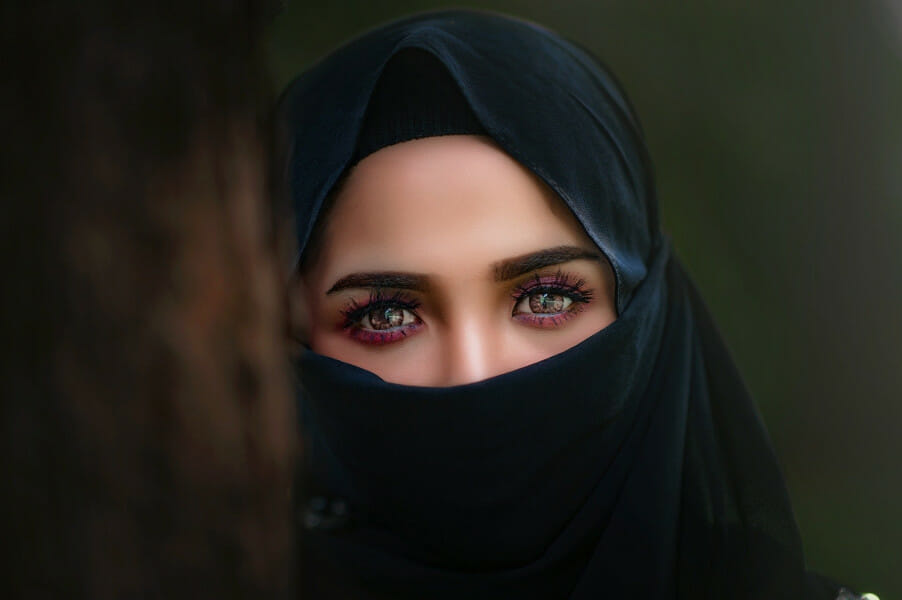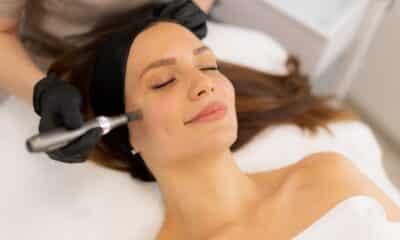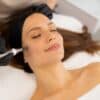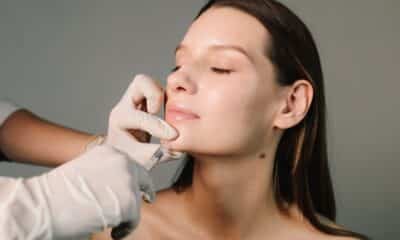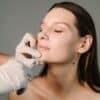Learn How To Keep Your Eyes Healthy While Wearing A Mask
COVID-19 has introduced us to an entire vocabulary’s worth of new terms (remember six months ago, when you’d never heard the words, “social distancing”?), but as far as skin-care goes, the one you’ll hear the most often is “maskne.”
Though this sort of jawline acne has gotten all the credit on the internet and during tele-derm office visits, our new mask-wearing way of life has opened the floodgates for all kinds of different skin issues. And one that no one seems to be talking about? How it affects the delicate skin around our eyes.
As an oculofacial plastic surgeon, I’ve seen all kinds of different ways that wearing a mask can impact the under-eye area, and regularly get questions about what’s going on. To spare you an exhaustive Google search on the subject, I’ve cleared up some of the most common confusion below. And yes: There are some masks that are better for your eyes than others. Read on to find out which ones.
Are there any lasting effects from steamy mask breath getting pushed towards your eyes?
What’s interesting about that is the redirected airflow is accelerating the evaporation of your tears so the eye isn’t able to maintain its normal moisture levels. Exhaled air getting directed toward the eye can cause or worsen dry eye, especially if you wear contact lenses. Dry eye manifests with symptoms like irritation, grittiness, feeling like you have sand in your eyes, or increased tearing. (Even though increased tearing may sound paradoxical, it’s basically your eye’s reflex response to compensate for the dryness).
But you can combat this by using over-the-counter lubricating drops. I always advise my patients that when it comes to choosing eye drops, the blander, the better. Steer clear of drops that make claims like ‘get the red out’. Those formulations tend to have additives in them that lead to increased irritation over time. Reputable brands of eye drops include Refresh, Genteal and Systane, which can all be found at your neighborhood drugstore.
Fortunately, the risk of permanent damage to the eye or delicate eyelid skin is low. This is more an issue of discomfort rather than lasting harm.
If your mask is too high, can it damage the delicate skin under your eyes?
Fun fact: Eyelid skin is the thinnest skin on the face, and subsequently the most delicate. When a mask rides too high, it can rub on delicate eyelid skin and cause irritation. This is especially known to occur with medical-grade masks with a tight seal. I have personally found that the more I attempt to make conversation while wearing a mask, either medical-grade or not, the more likely I’m going to have to deal with a mask that’s making its way towards my eyes. Typical facial expressions, like smiling, also shift the mask upwards into the eye area resulting in discomfort.
Since both masks and communication are necessary realities, here are a few strategies to cope with these issues. First off, I have found using masks with a moldable nose wire to be game-changing. Although it’s just a small modification, the impact is significant in getting a mask to stay in place. Additionally, I recommend prepping the lower lid skin with a layer of hydration to cut down on friction in case your mask does shift. Ingredients to look for in a well-formulated hydrating eye cream for this purpose include hyaluronic acid, squalane and ceramides. Consider applying the product about 15 minutes prior to putting your mask on to allow for proper absorption. Although I formulated epi.logic Eye Contact ($90) well before the pandemic, my bias has always leaned towards ultra-hydrating eye creams so this is an option to consider to soothe your mask-related eyelid woes.
When your eyes are the only part of your face that’s exposed, is there a higher risk of sun damage?
There isn’t a higher risk relative to normal but you still need to be diligent about protecting the sun-exposed areas. It may be tempting to forgo sunscreen since half of your face is covered. But as an oculofacial plastic surgeon, I have cared for countless patients who have developed skin cancers on the eyelids that are related to UV exposure. Also, accelerated aging changes around the eye due to sun damage are common complaints and are easily preventable. So be sure to put in the extra effort to protect your skin with SPF daily. Most sunscreens are safe to use on and around the eyelid region (without getting it in your eyes, of course). However, you’ll want to be picky about what type of sunscreen you use, as the area is delicate and sensitive. Mineral formulas, made with zinc or titanium dioxide, are a better choice for those with sensitive skin and they won’t sting your eyes as you sweat. There are also cosmetics made especially for the eye area that include sunscreen. Supergoop! Shimmershade ($24) serves double duty since it’s an eyeshadow with SPF 30 formulated from a hybrid of both mineral and chemical UV filters.
Although it’s important to apply (and reapply) sunscreen around the eyes daily, sunscreen doesn’t have to be your only line of defense—broad-brimmed hats and UV-blocking sunglasses help shade the face, keep sun out of your eyes—nd can help you keep a low profile (if that’s your thing) along with your mask.
Are there certain ways people should be changing their routines now that their eyes are the only thing exposed?
I’d say that the biggest adjustments that have to be made relate to the areas covered by the mask, rather than those that are left exposed. Reports of mask-related irritation and “maskne”—acne caused from the mechanical friction of fabric rubbing against the face—are rampant. As we are all experiencing, masks create a warm, moist environment on our skin which can set us up for issues with congestion, acne, and even inflammatory rashes. These times call for a pared-down, streamlined routine. Think gentle cleansers and light hydration. Steer clear of harsh scrubs, heavy-duty exfoliants, and thick creams. Prioritize ingredients like hyaluronic acid, aloe, and niacinamide to soothe stressed skin and break the cycle of irritation and reactivity.
What is your favorite type of sunscreen to wear around the eye area, and are there any best practices you’d recommend for application?
I touched on this briefly, but a mineral sunscreen I’ve been loving lately is Everyday Humans Gentle Mineral Sunscreen ($25). Mineral sunscreens are generally better tolerated around the sensitive eye area as some people can develop reactions to chemical sunscreens. There seems to be a never-ending quest for a mineral sunscreen that won’t leave the well-known dreaded white cast. Although Everyday Humans Gentle Mineral Sunscreen isn’t 100 percent sheer, it’s the closest I’ve come across so far. (Shout out to Brooke Devard of the Naked Beauty Podcast for the rec!)

